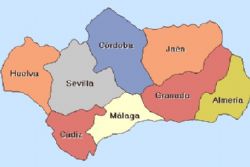- Business
- Childbirth & Education
- Legal Formalities
- Motoring
- Other
- Pensions & Benefits
- Property & Accommodation
- Taxes
- Airports and Airlines Spain
- Paramount Theme Park Murcia Spain
- Corvera International Airport Murcia Spain
- Join us for Tea on the Terrace
- When Expat Eyes Are Smiling
- Meet Wincham at The Homes, Gardens & Lifestyle Show, Calpe
- QROPS 2014
- Spain Increases IHT in Valencia & Murcia
- Removals to Spain v Exports from Spain
- The Charm of Seville
- Gibraltar Relations
- Retiro Park : Madrid
- Community Insurance in Spain
- Calendar Girls
- Considerations when Insuring your Boat in Spain
- QROPS – HMRC Introduces changes that create havoc in the market place
- QROPS – All Change From April 2012
- Liva & Laia : 15th November

The 3rd-largest contributor to Spain's economy, Andalusia, will challenge in court the debt ceilings introduced by Prime Minister Mariano Rajoy to force the regions to deepen budget cuts.
"The debt limits transform our deficit target into a surplus obligation," the southern region's president, Jose Antonio Grinan, told a news conference in Sevilla today. "It is impossible to generate a surplus in times of recession, short of scrapping all public services including state-funded education and health care."
Budget Minister Cristobal Montoro yesterday set debt limits for each region, averaging a combined 15.1% of GDP this year, 16% in 2013, 15.9% in 2014 and 15.5% in 2015. That compares with a regional debt-to-GDP ratio of 13.5% in the first quarter.
Rajoy is forcing the 17 semi-autonomous regions to carry out the bulk of Spain's 2012 budget-deficit reduction as he tries to avoid a second bailout. The country secured as much as €100 billion in EU loans in June to shore up its banks amid surging borrowing costs. Regional governments control more than a third of public spending, including health care and education.
Rajoy's 7-month-old government has bailed out the regions 4 times this year, risking its own access to markets by transfering funds and organizing as much as €41 billion in bank loans.
Data yesterday showed the central-government deficit rose to 4.04% of GDP in the first half, exceeding its full- year target. The limit for all levels of Spanish administration is 6.3%, down from a shortfall of 8.9% last year.
Borrowing Costs
The yield on Spain's 10-year benchmark bond fell 6 basis points to 6.69% today at 3:30 p.m. in Madrid on speculation the ECB may intervene to lower Spanish borrowing costs. The yield hit a euro-era high of 7.75% on July 25.
Grinan, in charge of the only Socialist region left in Spain, said Andalusia will have to reduce debt by €2.74 billion next year to comply with a ratio of 13.2% of GDP. Its plan was to let debt climb to 15.1% of GDP from 10.6% in the first quarter.
"We are taking resources away from health care and education to save the banks, that is intolerable," Grinan said.
He said that regions with lighter debt burdens should not be asked to make the same effort as others. Catalonia, the most indebted region, should do more than cap its debt at 23.6% of GDP next year, he said.
Catalonia, the biggest regional economy, boycotted yesterday's meeting with Montoro, while two other regions also ruled by regional parties, Asturias and the Canary Islands, voted against the rules.










